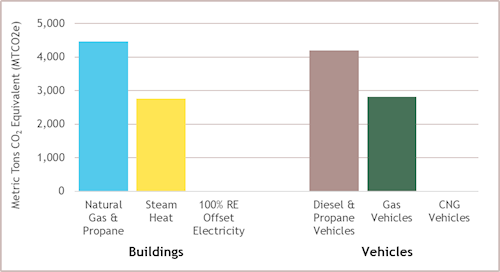
Dane County government leads by example in reducing emissions from our internal operations. Internal operations refers to emissions produced through the delivery of Dane County services; this includes our buildings and vehicles, land operations, and other county activities.
Internally our goals are to:
This page highlights our progress on these internal goals and other examples of how we lead by example. A full summary of Dane County's internal emissions for 2022 is available here.
From the Dane County Regional Airport and Alliant Energy Center to the Henry Vilas Zoo, the electricity in all Dane County operations is 100% renewable offset. That means we match every kilowatt of electricity we use in our operations to a kilowatt of renewable electricity that goes onto the local electric grid. Dane County is the first county in Wisconsin to be 100% renewable offset and the 4th county in the U.S.
Dane County's Renewable Offsets vs Total Electric Consumption
MWh from 2020 to 2030
Dane County operations is also working to become carbon neutral by 2030. Being carbon neutral means that, each year, the total emissions from Dane County's buildings and vehicles will be equal to (or less than) the amount of natural carbon sequestration Dane County achieves through the county's land operations (restoring land to prairie, for example).
The graph below illustrates the carbon neutrality goal: as emissions are reduced and the amount of verified natural carbon sequestration increases, these two bars will meet in 2030, achieving carbon neutrality.
Dane County's Progress on Carbon Neutrality in Building, Vehicle and Land Operations
(Metric Tons CO2 equivalent or MTCO2e)
Dane County's emissions from buildings and vehicles include all of the following:
Dane County also has greenhouse gas emissions associated with operating the Dane County landfill and with fugitive emissions. Those emissions are not included in the 2030 goal.
Dane County Building & Vehicle Emissions (MTCO2e)
To achieve our 2030 goal Dane County will further reduce remaining emissions so that the emissions are equal to or less than the total annual emissions sequestered via the County’s land operations. The graph below shows remaining emissions by source.
Estimated 2025 Dane County Building & Vehicle Emissions by Source (MTCO2e)

Research has shown that the restoration or conversion of land to permanent perennial vegetation can increase the amount of carbon stored within soils and reduce greenhouse gas (GHG) emissions from soils. This can have a positive effect on battling climate change. Dane County Land & Water Resources are currently researching the total tons of carbon sequestered through land operations on an annual basis for Dane County.